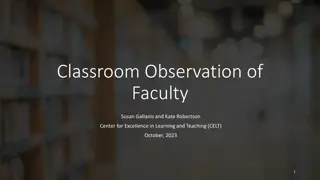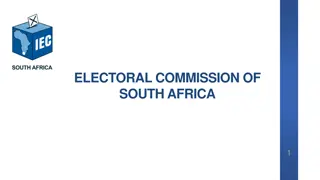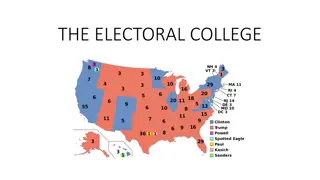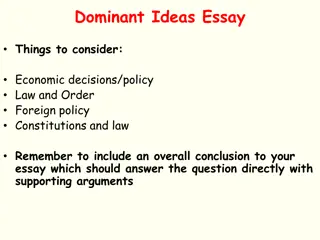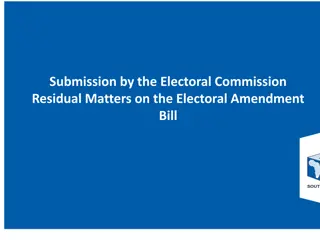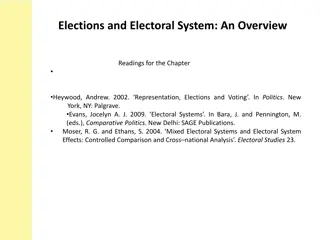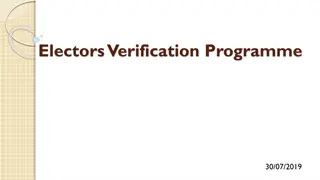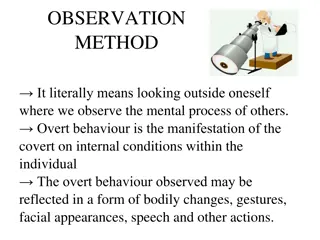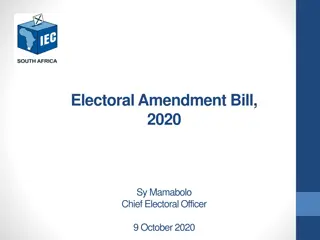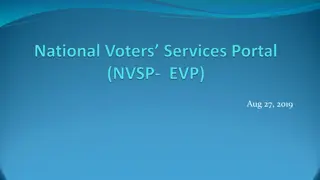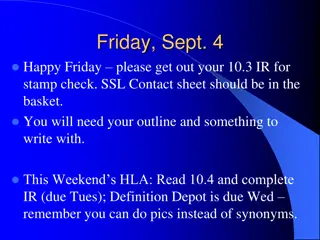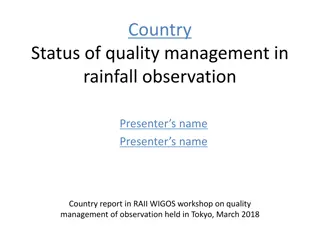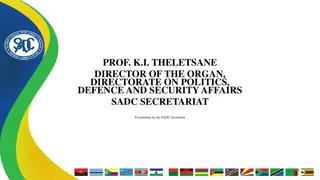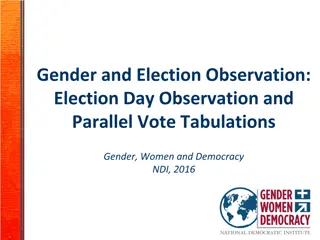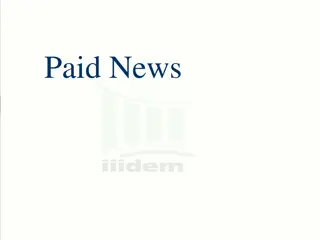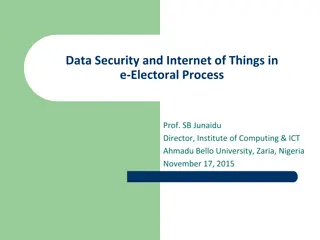Comprehensive Guide to Electoral Observation and Reporting
This comprehensive guide covers various aspects of electoral observation and reporting, including pre-election preparations, election day processes, and post-election verification. Topics discussed include legal frameworks, voter registration, election administration, political party registration, voter education, election campaigns, polling station logistics, ballot secrecy, and more. The guide aims to provide insights into ensuring transparent and fair electoral processes.
Download Presentation

Please find below an Image/Link to download the presentation.
The content on the website is provided AS IS for your information and personal use only. It may not be sold, licensed, or shared on other websites without obtaining consent from the author.If you encounter any issues during the download, it is possible that the publisher has removed the file from their server.
You are allowed to download the files provided on this website for personal or commercial use, subject to the condition that they are used lawfully. All files are the property of their respective owners.
The content on the website is provided AS IS for your information and personal use only. It may not be sold, licensed, or shared on other websites without obtaining consent from the author.
E N D
Presentation Transcript
Domestic Election Observation and Reporting
Electoral Observation Legal Framework Post- Election Verification of Results Planning & Implementatio n srt trm The Electoral Cycle Voting Training and Education Operations and Election Day Electoral Campaign Voter Registration long term medium term
Pre-election Observation (1) 1 ) Constitutional and legal framework for elections Critical question : How does the framework uphold principles and ethos of democracy ? 2 ) Boundary delimitation Critical issues : population size; convenience and accessibility of voters; pre-existing administrative and electoral district boundaries 3 ) Voter registration Critical Issues : Inclusivity, accessibility, susceptibility to fraud etc 4) Election administration Critical Issues : Composition, appointment and mandate of Election Management Body
Pre-election observation (2) 5) Registration of political parties and candidates Critical issues : Laws and regulations governing registration of parties and candidates 6) Voter Education Critical Issue : Comphrensiveness and information content, user friendliness including for people living with disabilities 7) Election campaign Critical issues : rules governing campaigns, security issues, funding of parties/resources etc
Election Day Observation (1) Voting Process Areas of focus : 1) Polling Stations Location (accessibility, political, demography, infrastructure) Opening Closure
Election Day Observation (2) 2) Election Materials (ballot papers, ballot boxes, booths, forms, etc) quantities user friendliness (handicapped) security
Election Day Observation (3) Secrecy of Ballot Polling Station layout Ballot papers Logistics Timely distribution of election material Appropriate quantities
Election Day Observation (4) Voters roll Multiple voting Intimidation Security of the poll Level of voters understanding of the process
Election Day Observation (5) Counting Process Clear procedures Transparent Security Staff training Accuracy Time frame for results processing
Election day and election observation (6) General environment Order Peaceful/Tense
Election Observation Reporting After election day, observers usually return to their secretariat for debriefing and reporting Type of reports: 1 ) Preliminary statement Captures a summary of the observation made, recommendations and conclusion of the observation Produced while EOM is still on ground
Election Observation Reporting (2) 2) Final Report Comprehensive report on the entire observation Can be produced after one or two Both preliminary statement and final report are sent to relevant election stakeholders such as EMBs, CSOs, political parties etc months
Structure of Report 1 ) Preliminary Report Introduction : Composition and period of deployment Objectives of the Mission Assess whether conditions existed for the conduct of elections that allow the people of Seychelles to freely express their will; Assess and determine whether the elections were conducted in accordance with the constitutional and legal framework for elections in Seychelles; Determine whether the final results of the electoral process as a whole reflect the wishes of the people of Seychelles; and Assess whether the elections met the benchmarks set out in PEMMO, SADC Principles and Guidelines governing democratic elections etc
Preliminary Report (II) Methodology of Observation Areas of deployment Interaction with stakeholders Attendance to election campaign rallies Observation of voting and counting operations Benchmarking instruments used Preliminary Findings Benchmarked on the legal framework, regional and international instruments Voter education, political tolerance, citizen participation in elections, voting and counting, results management
Preliminary Report (III) Recommendations Areas of improvement based on the Mission s assessment Conclusions A balanced appraisal of the whole observation process, and should explicitly state the Mission s position regarding the electoral process
Report Structure (II) Final Report Executive summary 2) Political and electoral background 3) The Electoral Framework 4) The Pre-election Phase 5) The Election Phase 6) The Post Election Phase 7) Conclusions and Recommendations 1)
Final Report (II) 1)The Executive summary A synopsis of the entire of observation covering type of elections observed, number of observers and regions deployed, instruments used to assess the electoral process, and conclusions made. 2) The Electoral Framework This is the institutional and legal context within which the elections are being organised The Constitution The Electoral Act The electoral system The political party registration and funding Act The code of conduct The Electoral Management Body appointment, composition, funding, powers and functions
Final Report (III) 3) The Pre-Election Phase Voter Registration Candidate nomination process Voter education and information Election campaign Media coverage of the electoral process 4) The Election Phase Polling station and provision of election material Voter s roll and voter turn out Voting operations : polling clerks, opening and closing of polls, voting procedures, security, voting from abroad, party agents, observers etc Counting process
Final Report (IV) 5) The Post Election Phase Results auditing Results centres Announcement of results 6) Conclusions and Recommendations Findings and conclusions Recommendations and areas of improvement
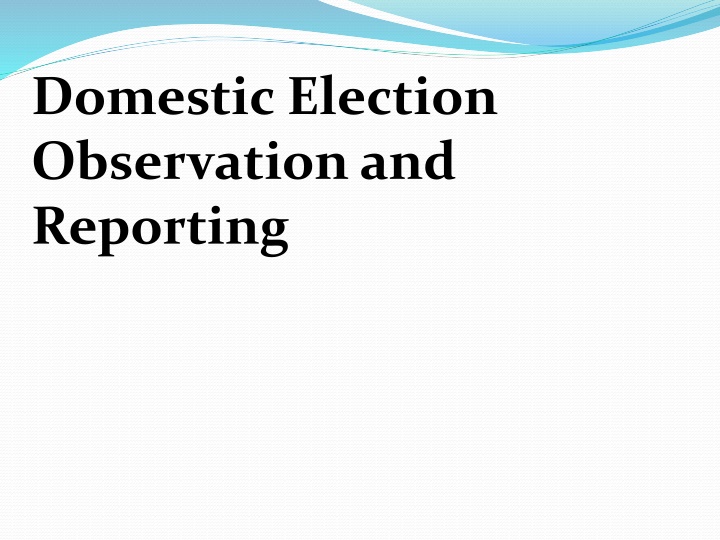

![RE: ELECTORAL MATTERS AMENDMENT BILL [ B42-2023]](/thumb/18837/re-electoral-matters-amendment-bill-b42-2023.jpg)



